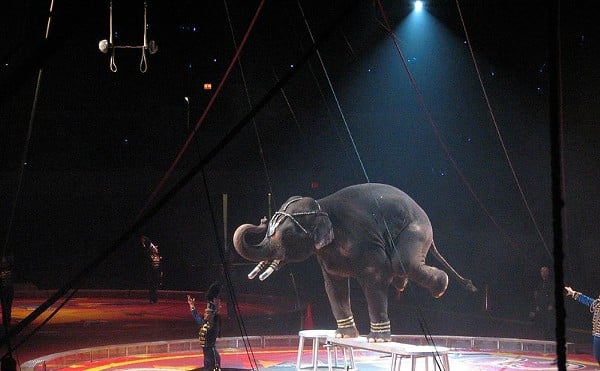Save for the lightning flashes of a distant thunderstorm, it is a pitch-black night on the Mississippi, a few miles downriver from Festus. A chorus of frogs and crickets drowns out the quiet hum of a small electric motor as Robin Parks navigates his boat in the still, shallow waters behind a dike.
Keith Riehn, Parks' full-time fishing buddy on the pair's Web broadcast hunting show Aim Low Bowfishing Journals, kneels on a platform at the boat's bow and hooks up a handheld spotlight. Parks kills the engine and they peer out into the darkness.
Riehn readies an arrow on the strings of his hunting bow while Parks picks up the spotlight and scans the river. The light reveals hundreds of iridescent fish floating near the surface. Picking out the biggest one, Parks douses the light to keep from spooking the creature and moves the craft to within ten feet of the target.
Parks then flicks on the light and in a split second Riehn takes aim. He pulls back and sends an arrow plunging into the water at nearly 100 miles per hour, yellow fishing line spooling after it. With a reel attached to the handle of the bow, Riehn labors to land the fish he has just impaled.
Soon, he pulls a wildly flopping, three-foot long, 30-pound bighead carp into the flat-bottomed johnboat. He clocks the fish on the head with a small wooden club and holds the trophy up by the gills for the cameraman to shoot. The arrow is lodged directly behind the fish's eye.
"That's the best place to hit 'em if you don't want much of a fight," Riehn deadpans into the camera, a smile sprouting from beneath his bushy goatee.
Parks and Riehn are two of the nation's biggest names in bowfishing, an unusual and aggressive form of angling that's become popular with archers from across rural Missouri. The first bowfishers association was founded in Arkansas in 1990, and today, there are 28 such organizations in fifteen states.
For the most part, the sportsmen's primary target is Asian carp, an invasive, plankton-feeding fish that has exploded in population over the past decade and, according to concerned marine biologists, become the scourge of Midwestern rivers.
"We've done studies on certain backwater refuges and over 95 percent of the fish species were Asian carp," says Steve Shults, an aquatic invasive species specialist with the Illinois Department of Natural Resources. "That's a tremendous problem."
For Missouri bowfishers, though, it means open season, no holds barred. Free of catch limits and other regulations, it is not uncommon for them to bag 2,000 pounds of the aquatic nuisance in a single trip.
Most carp hunters are driven by the adrenaline jolt that comes with seeking and destroying the fish, as opposed to hauling it home for dinner.
"Some people think it's wanton killing," notes Tim Hunter, president of the Missouri chapter of the Bowfishing Association of America. "But if you ever do it, it's as addictive as cocaine. You shoot your first fish and you'll be hooked."
The once-distant thunderstorm has rolled in and turned the Mississippi into a wash of whitecaps and driving rain, forcing our boat off the river after less than an hour of fishing.
Sitting in the back seat of Robin Parks' massive four-door Ford pickup, Keith Riehn has a decision to make. Parks wants to drive two hours south and fish until dawn at a spot just outside of Cape Girardeau, where the chance of rain this night is slim. But Riehn, a special-ed teacher at Fox High School in Arnold, has to be at work at 7 a.m.
"We gotta be outta there by 3:30," pleads Riehn, who hails from Pevely. "I can't call in sick on the first Friday of the school year."
"OK, but you know that's the time we usually get into the big fish," Parks says with a mischievous grin. An environmental engineer with the Army Corps of Engineers who lives in Hillsboro, Parks has the next day off. "If you call in sick we can play golf tomorrow."
Two hours later, Parks guns the outboard motor and speeds along the Ohio River, an hour east of Cape Girardeau on the Illinois-Kentucky border. Riehn is busy teaching a crash course on bowfishing, starting with the meaning of "Aim Low." Because light bends in the water and makes the fish appear deceptively close to the surface, shooters must set their sights on a spot about six inches below the actual target.
Picking up Parks' powder-blue bow, Riehn launches into a tutorial on the equipment. The bow is a compound, meaning it uses several pulleys and cables to help bend the weapon's limbs. It has a 45-pound "draw weight," the amount of force it takes to pull the string completely back and shoot. Once the string is cocked, however, the tension eases and holding the arrow in firing position is relatively easy.
The arrow (there's only one) is about three feet long and made of fiberglass. To keep the fish from sliding off, Riehn explains, the arrow has two steel barbs the size of small nails that protrude from the pointed tip at 45-degree angles. There's no fletching (the feathers normally used to stabilize it in flight) so that it can easily glide into the water, sticking targets as deep as five feet. A simple knot connects the tail of the dart to a length of 200-pound test fishing line and a reel just like the basic press-the-button-and-cast variety found on traditional poles.
"Native Americans have been using bows and arrows to catch fish for thousands of years," says Christine Appleberg, president of Illinois Bowfishers. "But modern bowfishing archery equipment didn't really take off until the 1970s, and even then it was guys using wooden arrows with nails bent back as the barbs. Now, in the last five years, it's become the fastest-growing segment of archery."
The last time I picked up a bow and arrow was summer camp in sixth grade. Now, after a few practice shots, I am sandwiched shoulder to shoulder between Parks and Riehn on the platform at the front of the boat. Parks mans the spotlight, panning it across the water to illuminate a sea of Asian carp floating like logs near the surface. Picking a target about five feet away, I draw back, shoot and miss completely.
After repeated misses, I'm ready to hand the bow back to the professionals. Finally, the line goes taut and a fish flops out of the water. My first catch is a silver carp barely ten inches long, shot through the dorsal fin.
"Oughta have that one mounted," Parks cracks.
Beginner's luck kicks in, and I start connecting on nearly every shot. Riehn picks up his bow and starts firing alongside me. The unsuspecting fish don't stand a chance as arrows rain down on them at close range.
Parks, tired of constantly stopping the boat to land paltry-size prey, instructs us to go after something serious. When Riehn spots what looks like a large bighead five yards to our right, we let our arrows fly and both hit pay dirt. With the shafts crisscrossing out its back, the carp is virtually lifeless as we reel it in.
To the amusement of my guides — who once bagged an eight-foot, 240-pound alligator gar — the three-foot, 25-pound fish is one of the biggest creatures I've ever caught. After posing for a picture, I toss it in a bucket and notice my hands are covered with a snot-like fishy slime. Hopelessly, I try to rinse them in the river, but the smell, having already oozed into my pores, won't leave my hands for days.
Psychologically, bowfishing is completely different from pole-and-line angling. This is not a matter of dangling a hook in the water and patiently hoping for an unseen fish to take the bait. Rather, nailing a fish with an arrow is an act of instant gratification. Not only are the carp visible at the surface, but it's possible to pick out the biggest one and spear it at near point-blank range. It is like shooting fish in a barrel.
The bighead carp is an ugly, stinky, slimy fish. Its defining feature is an oversized skull that bulges out from its silver-and-white body, like the cap on a mushroom. Eyes slung low on the sides of its head, it has a toothless, circular mouth, which contracts as it sucks in water to filter the plankton it voraciously consumes. As a result of its diet, it reeks of the combined stench of fish and composted grass clippings.
Common carp, native to Asia and Eastern Europe, have flourished in the nation's waterways since the early 1800s. Asian carp, common carp's larger relative, first appeared in American waters in the early 1970s when fish farmers in Arkansas stocked the silver, grass and bighead species to gobble up the plankton and algae that was polluting their aquaculture pens. Inevitably, some escaped.
Asian carp did not establish themselves in the wild until the early 1990s, their numbers rapidly increasing after the flood of 1993. According to one study, until 1992, commercial fishermen on the Mississippi and Illinois rivers inadvertently netted about 1,300 pounds of Asian carp annually. Since 1997, those same fishermen have caught more than 110,000 pounds of carp a year. The unwanted fish have been spotted in 23 states, including as far away as California and Florida.
"It's been less than ten years, and we are up to our knees in the fish," says Duane Chapman, an invasive fish expert with the U.S. Geological Survey.
According to Chapman, there's little hope the carp boom will slow anytime soon, for the fish thrive in the Midwest's shallow, slow-moving rivers. One mature female bighead lays nearly two million eggs a year.
The consequences of the unwanted proliferation are vast. Ecologists' biggest concern is that the carp will take plankton — the food on which virtually every type of newborn fish feeds — away from native species.
"Studies have shown the number of large zooplankton is down 90 percent and small zooplankton is down 50 percent," says Chapman. "That's a lot."
"We have a lot of species in the large rivers that are teetering on the edge," explains Kevin Meneau, a fisheries-management biologist with the Missouri Department of Conservation. "The fear is that the carp will compete for food and space, to the detriment of those species that are native and having a hard time."
The carp could someday impact humans as well. Because they consume only the largest varieties of plankton, the microscopic organisms they leave behind can spawn massive algae blooms that turn rivers greenish-blue, something Chapman says he's already seen in some local tributaries. In extreme cases, the plankton left behind by carp can turn water toxic to humans.
"If they get their density high enough they'll even cause microcystis, which is one of worst toxic algae bloom producers in the world," Chapman warns. "It can cause whole towns to get flu- or cold-like symptoms if the water treatment plant picks up that water."
To combat the carp conundrum, ecologists are emphasizing a containment strategy. To keep them out of the Great Lakes, two underwater electric fences have been erected in a ship canal outside of Chicago that connects the Mississippi River with Lake Michigan. A federal law enacted in 1900, the Lacey Act, imposes steep fines for transporting a live carp across state lines.
As for actually reducing or eliminating the nuisance fish, Chapman says there is but one option: "The only method we have in the short term is harvest enhancement."
As the Aim Low fishing boat motors down the center of the Ohio River, cameraman Jerad Wofford, an ex-Marine with the height and build of a power forward, huddles between the steel bars that prop up his camera stand to protect himself.
Dozens of silver carp are leaping from our wake, some reaching six feet in the air before splashing back into the water. Minutes earlier, one landed in the boat, flailing madly across the deck, slapping our ankles and coating everything it touched with its familiar goo. Now, as we pick up speed, it's an uneasy feeling knowing that one could pop out of the water and deliver a fierce, unexpected slap in the face.
"The thing that scares me isn't when you hear 'em jump," Wofford says nervously, "It's when you can't hear 'em land."
Silver carp are the slightly smaller cousins of bigheads. They jump when spooked by low-frequency vibrations and disturbances at the surface of the water, precisely the conditions created by an outboard motor on an aluminum-hulled fishing boat.
In the summer of 2004, Chris Brackett was living in his father's basement and struggling through his third year trying to make it as the host of his self-produced hunting and fishing TV show. Then he took a bowfishing trip with a handful of friends near his hometown of Peoria.
"I shot a few bigheads but got tired of it because they were too easy," recalls the 31-year-old Brackett, who appears in his videos sporting a backward hat and a black goatee. "I said 'Let's see if we can get some of them jumping ones up.' About the twelfth try, I shot one clean out of the air.
"The next day, I found another guy to take me out, and I paid a local kid twenty bucks to hold the camera. The first fish that jumped, I drilled it. Right then, I knew I had something pretty cool. I had to capitalize."
Brackett marketed his videos as Extreme Aerial Bowfishing. The tapes depict him and his buddies hooting and hollering as they cruise the river surrounded by swarms of fish, the water seemingly boiling with carp. He says he sold 10,000 DVDs in the first year.
"Even the misses are hilarious," Brackett says. "They're jumpin' in the boat and hittin' people on the face. People around here loved it."
He parlayed the success into his own cable show called Aerial Affliction, in which he hunts with a bow and arrow, everything from pheasants and doves to frogs and snapping turtles. These days when he goes bowfishing for silver carp he wears a hockey goalie's mask to keep from getting beaten up by the fish.
"It goes back to those primal instincts you had as a little kid," Brackett says of his show's appeal. "Somebody would always tell you, 'Man, you should have been here yesterday, they were jumping in the boat.' Well, now they really do."
But while the flying fish are good fun for Brackett and his buddies, many are quick to point out the silver carp's impact on the Midwest's recreational boaters.
Says Robert Rice, who calls himself an anti-carp environmental activist: "Just imagine little Jenny Johnson driving her jet ski at 40 miles an hour and getting whacked in the face with a fifteen-pound fish."
On the afternoon of May 4, 2008, Darin Opel was bowfishing for carp along the shore of the Melvin Price Locks and Dam in Alton, Illinois. He ran into a group of rod-and-reel fishermen sitting on the bank and stopped to strike up a conversation. The men had never seen a bowfisherman before and asked for a demonstration.
After a couple of misses, Opel spotted ripples on the water about 40 yards away. When the swell moved closer and the distinct suction-cup mouth of a bighead carp breached the surface, he took aim and unleashed the shot of his life.
The line snapped taut and screamed out of the reel. Opel worked the fish in only to see it take all of his line out again. Finally, he fought the carp to within a few feet of the bank. That's when Opel, who stands six-foot-four-inches and tips the scales at more than 300 pounds, wedged his bow behind a rock and jumped into the chest-deep water to engage his foe in hand-to-fish combat.
"I put my hand up through its gills and grabbed him by the tail," Opel remembers. "I'm fighting hard. I got him pinned up against the rocks, and finally I get him out of the water — and that's when I seen how big he was. I didn't know what to do."
Holding the fish in a bear hug, his bow dragging behind him, Opel sprinted to the top of the levy's steep embankment and dropped the whale of a carp, exhausted.
"The arrow stuck in his head came out his mouth and jabbed me in the kneecap and ripped a hole in my jeans," Opel recalls.
He drove the fish to his father's house and then to a certified scale at a grocery store in his hometown of Worden, Illinois. The bighead carp weighed in at 92 pounds, 8 ounces. It had a girth of 30 inches and was more than five feet long.
Chapman says it is the largest carp ever caught by a recreational fisherman in the Western Hemisphere.
Pulling into a bar in Edwardsville, Illinois, Opel is easy to spot. He sits in his monster-truck-size Ford, its back windows plastered with stickers from a half-dozen hunting and archery associations, along with the emblem of his local heavy equipment operators' union. Wearing a blue camouflage cap, a flannel shirt and a goatee, he looks like a supersized version of Larry the Cable Guy.
Once inside, Opel describes how the giant fish changed his life. Every local television network wanted a piece of the story. Says Opel: "The first one I called was Channel 4. I asked 'em, 'Are you going to send me Virginia Kerr?'"
The Associated Press later picked up the tale and it appeared in hundreds of papers from Los Angeles to London. His phone rang off the hook for two weeks, mostly from old friends wanting him to take them bowfishing. Equipment manufacturer Cajun Archery (sponsors of Aim Low Productions) agreed to give him free gear.
The equipment, he says, is the best thing that ever happened to him.
"You got that saying: When your hunting and taxidermy bills are above your yearly income, you know you're a redneck. Well, I'm like, 'I'm there,'" Opel says, pointing two thumbs at himself. "I put a lot of money into it."
Like all the bowfishers interviewed for this story, Opel is an outdoorsman in the most extreme sense of the word. His hunting season never ends. He traps raccoons, coyotes, bobcats, and bow-hunts everything from elk and mule deer to wild hogs and bears. He particularly enjoys traveling to Florida to bow-hunt alligators, which he's done every year since the state legalized the sport in 1988.
"I try to dissuade people from [shooting alligators with rifles] because to me that just isn't any fun," Opel says. "The fun is fighting him, getting on his turf, getting the shit scared out of you. I've been hunting gators for twenty years, and they still scare the shit out of me."
As for his record carp, it's still at the taxidermist's shop. The thought of eating the mammoth catch never even crossed his mind, because Opel, ironically enough, is allergic to fish. One bite and his throat swells shut in anaphylactic shock.
"That's why I tell everyone I make the ultimate fishing buddy," Opel beams. "You get to keep and eat everything I catch."
Throughout the Midwest, there are owners of private ponds battling the onslaught of Asian carp. There are city officials fighting the same infestations in their lakes. It doesn't look good. Who are they going to call? Carpbusters.
Founded in 2004, Carpbusters is the brainchild of Robert Rice, a 46-year-old property developer from Joplin. For years Rice was an active member of the Native Fish Conservancy, a nonprofit organization dedicated to preserving the habitats of indigenous fish species.
Fed up with what he perceived as inaction by the group toward the carp problem, he decided to take matters into his own hands. He created carpbusters.com, a website that connects people with carp problems in their local waterways with teams of archers itching to slaughter thousands of them in an afternoon. Groups as far away as Minnesota now use the service.
"We've had tournaments where we removed ten tons of carp from a lake," boasts Rice. "The only reason we didn't remove more was we couldn't afford the Dumpster fees."
His vigilante plan was not well received by the Native Fish Conservancy or by animal-rights activists who loathe bowfishing. "In the conservation world, harvesting large numbers of animals is a taboo topic," says Rice, describing his group as "the wild side" of conservation. "Well, unfortunately, we've asked the carp nicely to leave and they haven't."
As for Carpbusters' effectiveness at eradicating the invasive fish, Chapman, the geological survey's carp expert, says the plan only works in the smallest bodies of water. "They do target the larger fish, which produce a larger volume of eggs," he says. "But ultimately, it's a small part of the overall answer."
Chapman maintains that the only way to put a dent in the number of Asian carp is to make the fish more lucrative for commercial fishermen. The current market price for Asian carp is about ten cents a pound, causing most commercial fishermen to empty their carp-filled nets on the banks of the river and fill their freezers with a more valuable catch, like catfish.
When Rice heard Chapman's supply and demand theory in 2006, he got an idea. Chapman put Rice in contact with Andrew Clarke, a food sciences professor at the University of Missouri, and Ellen Dierenfeld, the animal nutritionist at the Saint Louis Zoo. Together they created "carp cakes."
The cakes consist of entire Asian carp — heads, entrails and all — ground up and re-formed into hockey-puck-size patties that resemble Jimmy Dean sausages. The carp cakes are fed to zoo animals, who would otherwise consume ocean fish like mackerel. Vitamins and supplements are added to tailor the cakes to each animal's specific dietary needs.
"We're processing them to make sure they're nutritionally balanced and then resizing them so animals of all sizes can eat them," says Dierenfeld, noting that the animals at the Saint Louis Zoo consume 40 tons of fish annually. "I'm hoping that we can have a win, win, win situation: clean out invasive species in the riverways, lower the use of marine fishes and have another income option for commercial fishermen."
Adds Rice: "Basically, we're taking lemons and making lemonade."
The cakes are still in the testing phase and are only being used at the Saint Louis Zoo and a handful of other facilities. Still, Chapman says it's an encouraging development, especially if consumer interest in the fish increases. He points to China, where carp are indigenous and have been a staple food source for centuries, as an example.
"The carp are in very bad shape in Chinese rivers; there's very few left partly because of overfishing," Chapman says. "To me, that means if they can overfish them there we can probably do it here, too."
Standing in the parking lot of a 7-Eleven in Festus, I tell Robin Parks, Keith Riehn and Jerad Wofford that I want to keep a carp from our trip to cook and eat. They look at me like I'm crazy.
"You couldn't pay me to eat one of those things," remarks Wofford, the cameraman.
"Let me know how it is," Parks says, shaking his head in disbelief. "I've never tried it."
How to get rid of the huge quantities of carp hauled in remains a touchy subject among some hunters.
"There's people that get into the habit of shooting fish and dumping them at the boat ramp," says Hunter. "That gives bowfishermen a bad name because there's no mistaking who left the fish — they're full of holes."
Most people do find ways to recycle the fish. For their part, Parks and Riehn like to donate their carp to "the turtle guy," a man they know who owns several snapping turtles that collectively consume more than 400 pounds of fish a week.
Darin Opel says he cleans every fish he catches and uses the meat as bait for his raccoon traps. Some give the meat to rod-and-reel fishermen to use as catfish bait, while others donate their fish to bird-of-prey sanctuaries, where hawks and eagles make quick work of the carp.
Some bowfishers actually do enjoy eating their catch.
"I just deep fry 'em, and the ribs are just absolutely fabulous," says Gary Allen, from Alton. "But most fishermen around here just turn their noses up at it."
"I'm not cleaning a single one of them stinkin' sonsabitches," Hunter, a farmer from New Madrid, says in a thick Ozark drawl. "They stink when they come out of water. They'll slime and crap all in the boat. They shit this green slime — nastiest smelling thing you ever smelled in your life. No way I'm eating that."
The biggest problem with cleaning and eating Asian carp is that they are an extremely bony fish. Looking at one flayed open on a cutting board, tiny white bones permeate almost every inch of the meat.
Allen and Chapman have both come up with their own methods of cleaning the carp. They have posted step-by-step photo guides to salvaging as much boneless meat as possible on the Illinois Bowfishers' website. Since Chapman scores the meat with a fillet knife, a tedious process, I elect to try Allen's method on my fish, a silver carp about two feet long.
After discarding the guts (the carp smells twice as bad inside as it does out), I follow the instructions and start by cutting off the bottom and top thirds of the fish, leaving just the rib cage. After an exasperating, gag-inducing, half-hour long process, I'm left with eight thin strips of meat, each with a single thick rib bone in the center. Allen refers to these as "carp pork chops."
In the end, a relatively large carp is reduced to half a plate's worth of fish sticks. Breaded, fried and drizzled with lemon juice, silver carp tastes just like tilapia or any other cheap, white-fleshed river fish.
In 2006, Bradford Street Press published the Invasive Species Cookbook, a guide to cooking everything from zebra mussels to Burmese pythons. A sample recipe from the book describes a dish called "Stuffed Nutria Hindquarters," referring to the South American muskrat-like rodent that has infested wetlands from Louisiana to Chesapeake Bay. The tome's tag line: "If you can't beat 'em, eat 'em."





